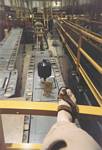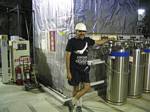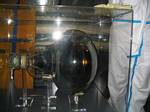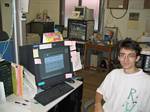Roger J. Wendell
Defending 3.8 Billion Years of Organic EvolutionSM



|
Science Stuff (See also my pages on Biology, Cosmology, Evolution, and Paleontology...) |

Capon

Krauss

Dr. Shane Huntington: "Laurence, you mentioned before there are a variety of projects in areas where Congress and others in the U.S. and I guess around the world, have concerns about funding this type of work. What is the justification for funding this sort of work, especially the stuff that's down at the very theoretical end?" Theoretical physicist Professor Lawrence M. Krauss: "You know, as far as I know, people don't ask the question, 'You know, what's the value of a Mozart symphony or a Picasso painting?' Science is a cultural activity, and it's produced some of the most amazing ideas that Humans have ever thought about. And, the cultural value of science, of understanding where we are and where we'come from, is the same as art, music and literature. Great art, music, and literature forces us to reassess our place in the cosmos. That's what science does at its best. And if we are so impoverished that we have to stop asking questions about where we came from and where we're going, it's indeed a sad time. These are the most interesting questions that humans have ever asked. And, by comparison to the money we spend on many other things, that isin my opinion much more useless, the investment is very small. And, so, if we are at the point where we have to say, look, we can't stop asking these esoteric questions, that change our picture of ourselves, then it's a sad time for humanity."
University of Melbourne Up Close
Episode 159, 2011 (transcribed by me)

|
Click Here for the Super Kamiokande Realtime Monitor! |


|
"...I think I can safely say that nobody understands quantum mechanics."
The Character of Physical Law 1965 |

|
Click Here for my page about Biology! |

|
Click Here for my page about Paleontology! |

|
Click Here for my page about Plants! |

|
Click Here for my page on Life... |

|
Click Here for my page on Evolution... |
There is No Consensus in Science

"I want to pause here and talk about this notion of consensus, and the rise of what has been called consensus science. I regard consensus science as an extremely pernicious development that ought to be stopped cold in its tracks. Historically, the claim of consensus has been the first refuge of scoundrels; it is a way to avoid debate by claiming that the matter is already settled. Whenever you hear the consensus of scientists agrees on something or other, reach for your wallet, because you're being had. "Let's be clear: the work of science has nothing whatever to do with consensus. Consensus is the business of politics. Science, on the contrary, requires only one investigator who happens to be right, which means that he or she has results that are verifiable by reference to the real world. In science consensus is irrelevant. What is relevant is reproducible results. The greatest scientists in history are great precisely because they broke with the consensus.
"There is no such thing as consensus science. If it's consensus, it isn't science. If it's science, it isn't consensus. Period."
- Michael Crichton at a 2003 lecture he gave at the California Institute of Technology

Sagan
"In an era when new technologies are constantly emerging, scientific literacy should be fundamental. On the other hand, it isn't necessary that you have four extra years of college sciences to understand them. You don't need to have a detailed knowledge of exactly how the physics works to appreciate the revolutions in quantum computing or cosmology. It is important, rather, to understand why these developments are significant, and how they are poised to change technology and our lives."
- Dave Goldberg and Jeff Blomquist
in their book, A User's Guide to the Universe, p. 3

Heisenberg

"Not only is the Universe stranger than we think, it is stranger than we can think."
- Werner Heisenberg in his book, Across the Frontiers
- Wilson Bryan Key
Subliminal Seduction, p. XIV
Bondi
- Professor Matt Cartmill, Duke University



In the early 2000s, Roger studied at LSU's CAMD facility and then at a test reactor in Maryland.
 Do Not Feed the Scientists! CAMD Synchrotron Facility, Louisiana State University, Baton Rouge |
 Roger visiting Roger at CAMD October, 2000 |
 R Summer 2001 |
|
KamLAND:
(Kamioka Liquid scintillator Anti-Neutrino Detector)
In May, 2004, RVW took us on this fantastic tour of KamLAND, a Neutrino detector he'd been working on a kilometer or two inside a Japanese zinc mine. We took a jeep ride into the bowels of the mine and then hopped out to get a close-up view the detector and the experiment KamLAND is engaged in. (Super-Kamiokande was the first experiment to show that neutrinos have a non-zero mass. However, even today we don't know exactly what the mass is, just that its much smaller than than of other particles. KamLAND confirmed that an important theory of neutrino oscillations and thereby confirmed that we have a good understanding of nuclear processes happening in the sun.) Click Here for KamLAND's homepage...
 1 |
 2 |
 3 |
 4 |
 5 |
 6 |
 7 |
 8 |
 9 |
 10 |

|
Click Here for more on our visit to Japan... |

|
Click Here for Roger A. Wendell's Neutrino Animation! |

The Three Families of Fundamental Particles:
Family 1
Particle 
Mass - in multiples
of the proton massElectric charge Weak charge Strong charge* Electron .00054 -1 -1/2 0 Electron-Neutrino <.00000001 0 1/2 0 Up Quark .0047 2/3 1/2 red, green, blue Down Quark .0074 -1/3 -1/2 red, green, blue Family 2
Particle 
Mass - in multiples
of the proton massElectric charge Weak charge Strong charge* Muon .11 -1 -1/2 0 Muon-Neutrino <.0003 0 1/2 0 Charm Quark 1.6 2/3 1/2 red, green, blue Strange Quark .16 -1/3 -1/2 red, green, blue Family 3
*Each type of quark can carry three possible strong-force charges that are labeled as colors that represent charge values.
Particle 
Mass - in multiples
of the proton massElectric charge Weak charge Strong charge* Tau 1.9 -1 -1/2 0 Tau-Neutrino <.033 0 1/2 0 Top Quark 189 2/3 1/2 red, green, blue Bottom Quark 5.2 -1/3 -1/2 red, green, blue
| Force | Force particle | Mass** |
| Strong | Gluon | 0 |
| Electromagnetic | Photon | 0 |
| Weak | Weak gauge bosons | 86 and/or 97 |
| Gravity | Graviton | 0 |

- Albert Einstein
in a 1942 letter to a friend

|
Miscellaneous Definitions: |
Relativity and Common Sense by Herman Bondi) Mathematicians say it's the time a body takes to turn through an angle of just over 57 degrees [180°/Π to be precise (Your browser may not be displaying 180 Degrees divided by Mathematical Pi)].

Papers, Theses, Dissertations, and other Text:
 Click Here for the YouTube video)
Click Here for the YouTube video)

A warm cup of quarks and leptons courtesy Peter Higgs and CERN.
(first posted on my FaceBook page April 16, 2020)
Julia Woithe et al 2017 Phys. Educ. 52 034001
Let's have a coffee with the Standard Model of particle physics!
Neutrinos, Mass, and the Higgs Field
I've asked how a Neutrino achieves mass. In April 2023, I cobbled together this answer from a couple of sources:
The "slowing down" is exactly the analogy often used to describe how particles acquire mass from the Higgs field. The more a particle interacts the heavier (and slower) it becomes. If it were not for those interactions all particles would travel at the speed of light. Neutrinos don't interact much, so they are very light and travel close to the speed limit. Photons don't interact at all.
Essentially all fundamental particles are thought to be just excitations in their respective fields - a bit like waves in the ocean. Interestingly scientists don't know if this is the mechanism neutrinos get mass. It's a possibility, but there are others. However, all the other elementary particles get their mass from interactions with the Higgs Field.

Links, Pix, Games and Graphs:
|
|

 Back to Roger J. Wendell's Home Page...
Back to Roger J. Wendell's Home Page...
Abbey |
About |
Blog |
Contacting
Me |
Copyright |
Disclaimer |
Donate |
Guest
Book |
Home |
Links |
Site
Index |
Solutions |
Terms,
Conditions
and
Fair
Use |
What's
Changed
or
New?
Copyright
© 1955 -